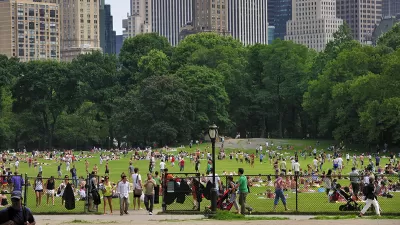In the newest edition of his classic book Guide to California Planning, Bill Fulton says there is still tension between the state's suburban planning system and its urban reality.

California in the 2020s is a mature urban beast: expensive, crowded, running out of land, and—at least for the moment—losing population. But the California planning system is, to some extent, still stuck in the growing suburban state of the 1980s. It’s focused on growth management, impact fees, subdivision approvals, and, thanks to the California Environmental Quality Act, making sure that bad things don’t happen.
In the past, I have always assumed that at some point this system would be comprehensively overhauled to reflect California’s new urban reality. But over the past year, as I revised Guide to California Planning for the sixth time in the last 30 years, I came to realize that this is never going to happen. Yes, the Legislature wants to make significant changes on certain issues: housing in particular, but also, for example, CEQA as a result of the Berkeley enrollment case. But no one in Sacramento sees any percentage in a comprehensive overhaul.
The Sixth Edition of Guide to California Planning is now available as an e-book. You can buy it here. The printed edition will be available later this year. And, like most previous editions, it reflects the tension that exists between the urban state we have today and the suburban-era planning system that emerged in the 1970s and ‘80s.

Study: Maui’s Plan to Convert Vacation Rentals to Long-Term Housing Could Cause Nearly $1 Billion Economic Loss
The plan would reduce visitor accommodation by 25,% resulting in 1,900 jobs lost.

North Texas Transit Leaders Tout Benefits of TOD for Growing Region
At a summit focused on transit-oriented development, policymakers discussed how North Texas’ expanded light rail system can serve as a tool for economic growth.

Why Should We Subsidize Public Transportation?
Many public transit agencies face financial stress due to rising costs, declining fare revenue, and declining subsidies. Transit advocates must provide a strong business case for increasing public transit funding.

How Community Science Connects People, Parks, and Biodiversity
Community science engages people of all backgrounds in documenting local biodiversity, strengthening connections to nature, and contributing to global efforts like the City Nature Challenge to build a more inclusive and resilient future.

Alabama: Trump Terminates Settlements for Black Communities Harmed By Raw Sewage
Trump deemed the landmark civil rights agreement “illegal DEI and environmental justice policy.”

Dear Tesla Driver: “It’s not You, It’s Him.”
Amidst a booming bumper sticker industry, one writer offers solace to those asking, “Does this car make me look fascist?”
Urban Design for Planners 1: Software Tools
This six-course series explores essential urban design concepts using open source software and equips planners with the tools they need to participate fully in the urban design process.
Planning for Universal Design
Learn the tools for implementing Universal Design in planning regulations.
City of Santa Clarita
Ascent Environmental
Institute for Housing and Urban Development Studies (IHS)
City of Grandview
Harvard GSD Executive Education
Toledo-Lucas County Plan Commissions
Salt Lake City
NYU Wagner Graduate School of Public Service





























